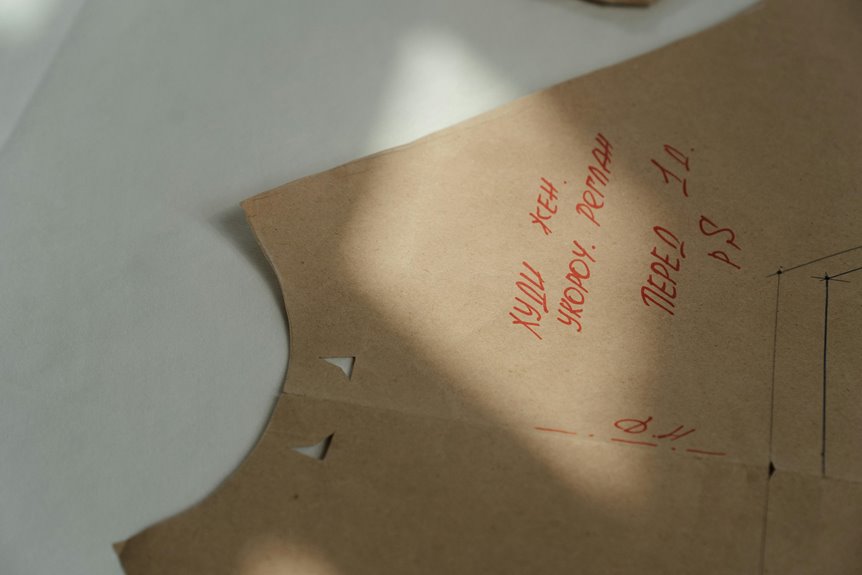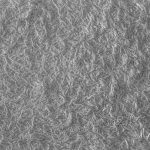When sewing silk charmeuse, choose sharp scissors and fine pins to handle its slippery, lustrous surface carefully. Use a fine Microtex needle (size 60/8 or 70/10) with silk or fine polyester thread, stitching slowly at 2.0–2.5 mm length. Cut single fabric layers on a flat surface to avoid slipping, and finish seams with narrow zigzags. Press gently with a cloth on low heat to protect the delicate fibers. Keep these basics in mind, and you’ll be ready to master more advanced techniques.
Table of Contents
Key Takeaways
- Use sharp Microtex needles (size 60/8 or 70/10) and fine silk or polyester thread for smooth stitching without snags or puckering.
- Cut silk charmeuse in single layers on a flat surface with sharp scissors or a rotary cutter to prevent slipping and ensure accuracy.
- Sew with a stitch length of 2.0–2.5 mm, using a walking foot and adjusted tension to avoid fabric distortion and thread breakage.
- Handle fabric gently, pre-wash to prevent shrinkage, and secure layers with fine pins or clips to maintain alignment during sewing.
- Finish seams with narrow zigzag stitches or a serger, and care by hand washing cold, ironing low with a pressing cloth, and storing properly.
Understanding Silk Charmeuse: Characteristics and Uses
Silk charmeuse stands out for its lustrous sheen and smooth, flowing texture. When you work with it, you’ll notice how gracefully it drapes, making it ideal for elegant garments like blouses, dresses, and lingerie.
Silk charmeuse’s lustrous sheen and graceful drape make it perfect for elegant, flowing garments.
This fabric’s lightweight nature allows it to move beautifully, enhancing the silhouette of whatever you create. Silk charmeuse’s two distinct sides—the shiny front and the dull back—offer versatility in design.
You’ll appreciate its breathability, which keeps garments comfortable in warm weather. However, silk charmeuse can be slippery and delicate, requiring careful handling to avoid snags or distortion.
Knowing these characteristics helps you decide how best to incorporate this luxurious fabric into your projects, ensuring your finished piece not only looks stunning but also feels exquisite to wear.
Choosing the Right Tools for Sewing Silk Charmeuse
Because charmeuse is slippery and delicate, choosing the right tools is essential to sewing it successfully. You’ll want a sharp pair of fabric scissors or a rotary cutter to achieve clean, precise cuts without snagging the fabric. A cutting mat helps protect surfaces and keeps your measurements accurate.
Use fine pins or fabric clips to hold pieces together gently—avoid thick pins that can leave marks or holes. A pressing cloth is a must to protect charmeuse from direct heat when ironing, preventing shine or burns.
Consider using a walking foot on your sewing machine to help feed the slippery fabric evenly through the machine. These tools will make handling charmeuse easier, ensuring your project turns out smooth and professional.
Selecting Needles and Thread for Optimal Results
When working with silk charmeuse, choosing the right needle and thread is essential to avoid snags and puckering.
You’ll want to use fine, sharp needles and smooth, strong threads that glide easily through the fabric.
Let’s explore the best options and tips to guarantee your stitches look flawless.
Best Needle Types
Choosing the right needle can make or break your sewing project with charmeuse fabric. You’ll want a fine, sharp needle to prevent snags and runs. A size 60/8 or 70/10 universal or sharp needle works best for this delicate, slippery fabric.
Avoid ballpoint needles, as they can cause skipped stitches or damage the fabric’s surface. Microtex needles are excellent choices because their thin, sharp points glide through charmeuse smoothly, minimizing fabric distortion.
When sewing, change your needle regularly to maintain clean, precise stitches and reduce the risk of fabric damage. Using the right needle guarantees your seams look professional and your fabric stays flawless throughout your project.
Keep needles fresh and appropriate for silk charmeuse to achieve the best results.
Thread Choices Explained
Selecting the right thread is just as essential as picking the perfect needle for your silk charmeuse project.
You’ll want to choose a fine, high-quality thread that won’t weigh down or damage the delicate fabric. Silk thread is ideal because it matches charmeuse’s natural sheen and drape, creating nearly invisible seams.
If silk thread isn’t available, opt for a fine polyester thread, which offers strength and some stretch without bulk. Avoid heavy cotton threads, as they can create puckering or pull the fabric.
Also, consider color matching carefully; a thread that blends well keeps your stitches discreet.
Using the right thread guarantees your finished piece looks smooth and professional, preserving charmeuse’s luxurious feel and fluidity throughout your sewing process.
Needle and Thread Tips
Pairing the right thread with an appropriate needle can make all the difference in handling silk charmeuse. Choose a fine, sharp needle, like a size 60/8 or 70/10, to pierce the delicate fabric without causing snags or runs.
Using a universal or sharp needle guarantees clean stitches and prevents fabric damage. For thread, opt for a lightweight polyester or silk thread that matches your fabric’s weight and sheen. Avoid thick or coarse threads that can create puckering or uneven seams.
Always test your needle and thread combination on a scrap of charmeuse before sewing your project. This lets you adjust tension and stitch length for smooth, flawless seams.
With the right tools, you’ll achieve professional, elegant results every time.
Preparing Silk Charmeuse Fabric for Cutting
Before you start cutting your silk charmeuse, make sure to pre-wash it carefully to avoid shrinkage later.
Handle and store the fabric gently to prevent snags and wrinkles.
When marking, choose methods that won’t damage the delicate surface.
Pre-washing Techniques
One essential step in preparing silk charmeuse fabric for cutting is pre-washing it properly to prevent shrinkage and maintain its delicate sheen.
You want to handle it gently to keep the fabric’s luster intact. Here’s how to do it right:
- Fill a clean basin with lukewarm water and add a mild detergent designed for silk or delicate fabrics.
- Submerge the fabric gently, avoiding twisting or wringing, and let it soak for about 3-5 minutes.
- Rinse thoroughly with cool water until all soap is removed.
- Lay the fabric flat on a clean towel, then roll it up to press out excess water—never wring it.
This careful pre-washing guarantees your silk charmeuse stays beautiful and ready for precise cutting.
Handling and Storage
Though silk charmeuse feels delicate, you can handle and store it carefully to keep it smooth and snag-free before cutting. Always wash your hands first to avoid transferring oils or dirt.
Lay the fabric flat on a clean, smooth surface when working with it, as folding can cause creases that are tough to remove. If you need to fold it for storage, use acid-free tissue paper between layers to prevent wrinkles and snags.
Roll the fabric around a tube or bolt to avoid sharp creases, and store it in a breathable cotton bag rather than plastic to reduce moisture buildup. Keep the fabric away from direct sunlight and harsh lighting, which can fade or weaken silk over time.
This careful approach guarantees your silk charmeuse stays pristine for sewing.
Marking Methods
Since silk charmeuse is slippery and delicate, choosing the right marking method is crucial to avoid damaging the fabric or leaving permanent marks. You’ll want to pick a method that’s gentle yet visible enough to guide your cutting and sewing.
Here are four effective marking methods for silk charmeuse:
- Tailor’s chalk – Use softly to avoid crushing the fabric’s sheen.
- Water-soluble pens – Mark lightly; they disappear with a damp cloth.
- Tracing paper and wheel – Provides precise lines without direct contact.
- Thread tacking – Temporarily hand-baste with contrasting thread for markings.
Avoid permanent markers or pins that might leave holes or stains.
Always test your marking tool on a scrap piece first to verify it won’t damage your silk charmeuse.
Cutting Techniques to Prevent Slipping and Fraying
When you cut silk charmeuse, you need to handle it carefully to prevent slipping and fraying. Lay your fabric on a smooth, flat surface, and use pattern weights instead of pins to keep it steady.
Sliding can cause uneven edges, so work slowly and keep your scissors sharp for clean cuts. Using a rotary cutter with a cutting mat also helps maintain precision and reduces fabric shifting.
To minimize fraying, cut just before sewing and avoid unnecessary handling. If you must move the fabric, support it fully to prevent stretching.
Consider cutting single layers rather than folded fabric to guarantee accuracy. These careful cutting steps will save you time and frustration, making your silk charmeuse project much easier to sew and finish beautifully.
Sewing Machine Settings for Silk Charmeuse
When sewing silk charmeuse, you’ll want to choose a fine needle to prevent snagging the delicate fabric.
Adjust your stitch length to a shorter setting for secure seams without puckering.
Don’t forget to fine-tune your machine’s tension to keep stitches balanced and smooth.
Needle Type Selection
Although silk charmeuse is delicate, choosing the right needle can make your sewing experience much smoother.
Using the wrong needle might cause snags, skipped stitches, or even fabric damage. Here’s how to pick the perfect needle:
- Use a fine, sharp needle like a size 60/8 or 70/10 to prevent holes.
- Opt for a sharp or microtex needle designed for delicate fabrics for cleaner stitches.
- Avoid ballpoint needles since they can create runs in the silk fibers.
- Change your needle frequently, especially after sewing several yards, to maintain stitch quality.
Stitch Length Recommendations
Choosing the right needle sets you up for smooth sewing, but stitch length plays an equally important role in handling silk charmeuse.
You’ll want to set your stitch length between 2.0 and 2.5 mm. This range prevents the fabric from puckering or gathering while keeping seams secure. Too short a stitch length can cause the delicate fibers to weaken and tear, while too long a stitch risks loose seams that won’t hold well.
When sewing curves or corners, you might reduce stitch length slightly for better control. Always test your stitch length on a scrap of charmeuse before starting your project to guarantee smooth, even stitching.
Adjust as needed, but keep it moderate to protect the fabric’s sheen and drape.
Tension Adjustment Tips
Adjusting your sewing machine’s tension is essential for working with silk charmeuse, as this delicate fabric requires a balanced stitch to avoid puckering or thread breakage.
Here’s how to fine-tune your machine:
- Start with a slightly lower tension setting than usual to prevent pulling the fabric tight.
- Test on a fabric scrap, checking both top and bobbin stitches for evenness.
- Adjust incrementally—tighten or loosen the tension dial by one or two notches until the stitches lay flat without puckering.
- Use a fine needle and high-quality silk thread to complement the tension adjustments and maintain smooth stitching.
Hand Sewing Tips for Delicate Seams
When you hand sew delicate seams on silk charmeuse, using a fine needle and lightweight thread makes all the difference. Choose a sharp, size 9 or 10 needle to prevent snagging. Opt for silk or fine polyester thread to match the fabric’s lightness.
Sew slowly, taking small, even stitches to maintain control and avoid puckering. Avoid pulling the thread too tight; gentle tension keeps the fabric smooth.
Pin your pieces carefully with fine silk pins or clip instead to prevent holes. Work in good light and use a thimble if needed to protect your fingers.
Finally, press seams gently with a cool iron and a pressing cloth to preserve the fabric’s sheen and texture. These steps help you achieve flawless, delicate seams.
Managing Seams and Seam Allowances
Though silk charmeuse is slippery and delicate, you can manage seams and seam allowances effectively by planning carefully.
Silk charmeuse may be slippery and delicate, but careful planning ensures smooth, manageable seams and allowances.
Start by choosing the right seam allowance; a narrow 1/4 to 3/8 inch works best to reduce bulk. Next, use fine, sharp pins or clips to keep fabric layers aligned without causing snags.
Then, sew slowly with a short stitch length to maintain control and prevent puckering. Finally, press your seams gently with a low-heat iron and a pressing cloth to avoid damaging the fabric.
Follow these steps:
- Opt for a narrow seam allowance (1/4 to 3/8 inch).
- Secure layers with fine pins or clips.
- Sew slowly using a short stitch length.
- Press seams carefully with low heat and a cloth.
This approach guarantees clean, smooth seams on your silk charmeuse project.
Finishing Edges and Preventing Fraying
Since silk charmeuse frays easily, finishing edges properly is crucial to maintain your garment’s durability and appearance.
Start by trimming seam allowances neatly to reduce bulk. Use a narrow zigzag stitch or a serger to secure raw edges, preventing fraying without adding stiffness. If you don’t have a serger, pinking shears can help, but they’re less effective.
For a clean, professional look, consider French seams or bias binding to enclose edges completely. When stitching, handle the fabric gently to avoid stretching or distorting the delicate fibers.
Always test your chosen finishing method on scrap fabric first to verify it complements the charmeuse’s fluid drape. Taking these steps will keep your silk garment looking polished and lasting longer.
Pressing and Ironing Silk Charmeuse Safely
Mastering three key steps will help you press and iron silk charmeuse safely without damaging its delicate fibers.
First, always use a low heat setting on your iron to avoid scorching.
Second, place a clean, damp pressing cloth between the iron and fabric to protect the sheen and prevent shine marks.
Third, avoid using steam directly on the fabric unless you test on a scrap first.
Finally, press gently without sliding the iron to prevent stretching or distortion.
- Set your iron to the lowest silk or synthetic setting.
- Use a damp pressing cloth as a protective barrier.
- Test steam on a fabric scrap before applying.
- Press with a lift-and-set motion to maintain fabric integrity.
Follow these steps to keep your silk charmeuse looking flawless.
Troubleshooting Common Issues When Sewing Charmeuse
When you sew with silk charmeuse, you’ll likely encounter some unique challenges due to its slippery texture and delicate nature. To prevent fabric shifting, pin carefully using fine silk pins or clip edges instead.
Use a sharp, fine needle like a size 70/10 to avoid snagging. If puckering occurs, check your tension and consider lengthening your stitch slightly. Avoid stretching the fabric while sewing to keep seams smooth.
When cutting, lay charmeuse on tissue paper for stability. If your fabric frays excessively, finish seams with a narrow zigzag or French seam.
Finally, test your stitches on a scrap before sewing your project, so you can adjust settings and avoid mishaps on your garment.
Care and Maintenance of Silk Charmeuse Garments
Although silk charmeuse feels luxurious and delicate, you can keep your garments looking their best with proper care. Treating the fabric gently protects its sheen and softness.
- Hand wash cold: Use mild detergent, avoid wringing, and rinse thoroughly.
- Dry flat or hang: Keep it away from direct sunlight to prevent fading.
- Iron with care: Use a low heat setting and a pressing cloth to avoid scorching.
- Store properly: Hang on padded hangers or fold with acid-free tissue to prevent creases.
Avoid bleach and harsh chemicals, as they damage silk fibers.
Frequently Asked Questions
Can Silk Charmeuse Fabric Be Dyed at Home?
You can dye silk charmeuse at home using acid dyes or fiber-reactive dyes designed for silk. Just be sure to follow safety guidelines and test on a small piece first to achieve the color and avoid damage.
Is Silk Charmeuse Suitable for Upholstery Projects?
You wouldn’t want to upholster your couch with silk charmeuse—it’s as delicate as a whisper! It’s prone to snagging and staining, so it’s better suited for garments, not heavy-use upholstery projects in your home.
How Does Silk Charmeuse Compare to Satin in Luxury?
You’ll find silk charmeuse exudes a natural, soft luxury with a subtle sheen, while satin offers a glossy, polished finish. Both feel luxurious, but charmeuse feels more delicate and breathable, perfect for elegant, lightweight garments.
What Are Eco-Friendly Alternatives to Silk Charmeuse?
You crave luxury but want to tread lightly; consider Tencel charmeuse or organic cotton satin. These eco-friendly alternatives offer silky softness without harming the planet, letting you sew with conscience and style simultaneously.
Can Silk Charmeuse Be Used for Winter Clothing?
You can use silk charmeuse for winter clothing, but it’s lightweight and not very insulating. Layer it with warmer fabrics or use it for elegant linings to keep cozy while enjoying its luxurious feel and sheen.
- Does Chiffon Fabric Stink - July 15, 2025
- Does Chiffon Fabric Affect the Economy - July 15, 2025
- Does Cotton Fabric Have a Nap - July 15, 2025







